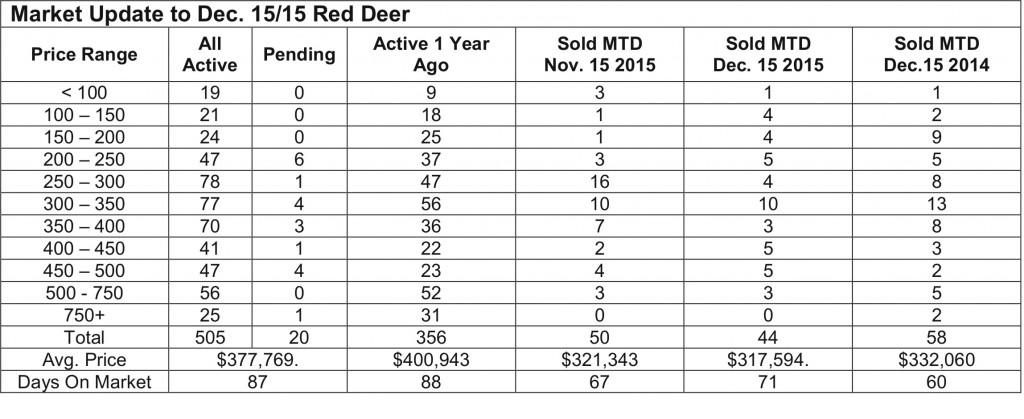December 17, 2015- Additional Market Update
Wednesday, December 23rd, 2015The 10 best (non-oil) things about Alberta’s economy
12/17/2015
Special to The Globe and Mail
Published Thursday, Dec. 17, 2015
While it was booming, Alberta’s petroleum sector was a gravitational black hole that sucked up everything else around it. Other industries scrambled to compete for labour, office space and investment capital. It’s a challenge for a tech firm, for example, to open an office in Calgary when a receptionist could command $75,000 a year.
Today, Alberta is grappling with an energy patch that has lost its gravity, at least for now. Oil is below $40 (U.S.) a barrel, and it won’t come suddenly roaring back in 2016. This winter will be difficult for thousands who’ve been thrown out of work.
But Alberta has plenty of fantastic ace cards, none of which depends on the price of oil. It’s time the province starts playing them. Consider this Top 10 list of assets that any economic developer would salivate over:
10. Wind and sun
Given the world’s desire to use less fossil energy, being a very sunny and windy place has its merits. By some measures, Alberta’s potential for solar energy is 40-per-cent better than Germany’s. And in that country, solar energy is not some pie-in-the-sky fantasy for future generations. It’s happening now.
9. Air transport infrastructure
Calgary International Airport is home to Canada’s longest runway, able to handle the largest transcontinental cargo vessels. The continuing $2-billion in development includes the new International Terminal (geothermally heated and cooled), which will further solidify Calgary as the transportation and logistics hub of Western Canada.
8. Leading universities
Both the University of Alberta and the University of Calgary are recognized among the best research institutions in the country, if not the world. We want creative, innovative and adaptable citizens, and these two schools are leading the way.
7. Agricultural resources
The world might want energy, but it needs food. In the 1860s, John Palliser reported back to the British Parliament that this part of the Northwest Territories (now Alberta) was entirely unsuitable for agriculture. It took decades of irrigation canals, advances in agricultural science, drought-resistant seed technology, and plenty of hard work. But today, Alberta exports not only food products, but science and innovation on food production as well.
6. Lake Louise
Enough said.
5. Progressive mayors
In 2015, reputation and leadership are increasingly scarce resources. Toronto was embarrassed on the world stage by former mayor Rob Ford a couple of years ago, while the mayors of Alberta’s major cities helped their municipalities rise to the top. They’ve been featured by the BBC, in The Economist and on Al Jazeera – but unlike Toronto, for all the right reasons.
4. Engineers
With the oil slump, a lot of them have suddenly found themselves with some free time on their hands. But that’s an asset if they can be channelled into other non-petroleum industries. Engineers are great at solving problems, and Alberta has a few at the moment. For example, how can we turn ourselves into champions – rather than chumps – of the war on carbon?
3. Available office space
Construction cranes are still dotting the skylines of Calgary and Edmonton, and a tsunami of commercial office real estate is about to flood the market. That’s a problem for developers, but a bonanza for companies in sectors such as finance, technology and transportation. Leasing deals will be sweet (and a lot of it comes with stunning views of the Rockies).
2. A strong, liberal democracy
Given the level of crazy around the world right now, a strong liberal democracy within a united and peaceful nation is not a bad thing to flaunt. The world is drowning in gun violence, religious insanity and Donald Trump. In Alberta, we debate the financing of new hockey arenas and whether we should redesign our licence plates. When protesters scale oil rigs, we lure them down with hot chocolate.
1. A young, educated work force
A young, educated and entrepreneurial work force is the most valuable economic asset of all. People haven’t moved to Alberta to sit on the couch and play Xbox. They’ve moved here to build something. Tapping into that energy is more valuable than what any hydrocarbon could ever be worth.
- Look at that list: renewable energy, modern infrastructure, great universities, food and crop science, progressive politicians, engineers, plenty of office space, a young and educated population – wrap that all up with jaw-dropping scenery and throw in liberal democracy.
The only question is: With all of this going for it, how could Alberta not succeed?
Todd Hirsch is the Calgary-based chief economist of ATB Financial and author of The Boiling Frog Dilemma: Saving Canada from Economic Decline.

